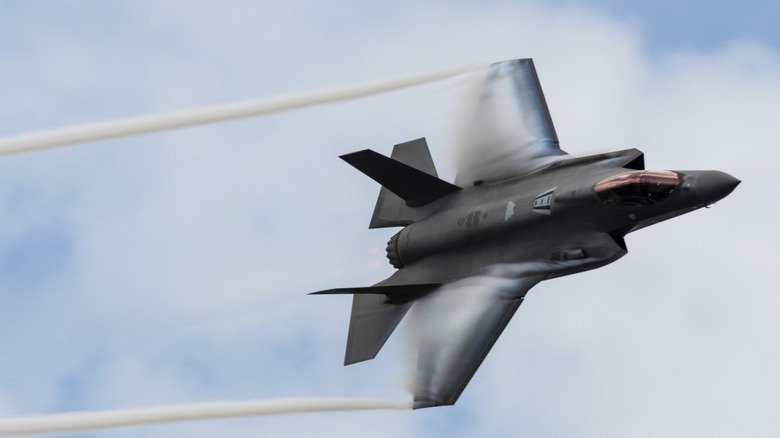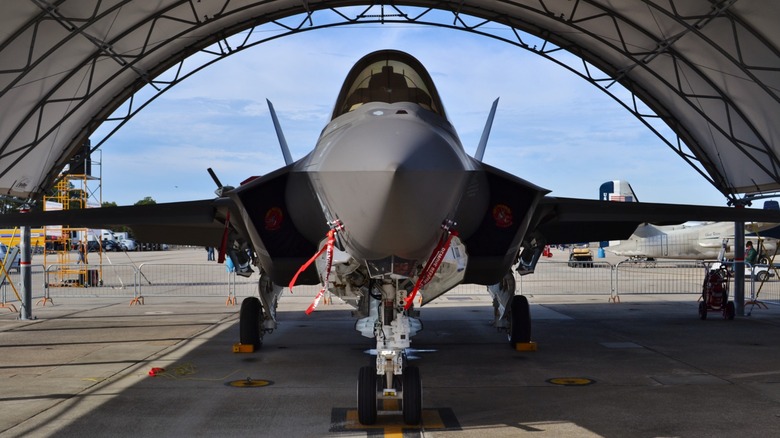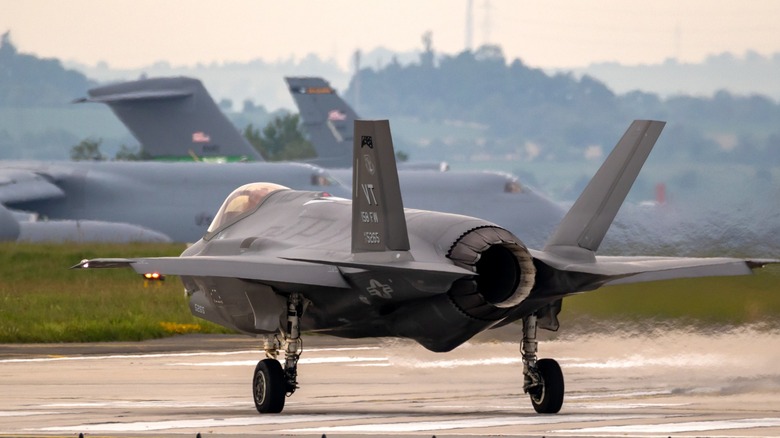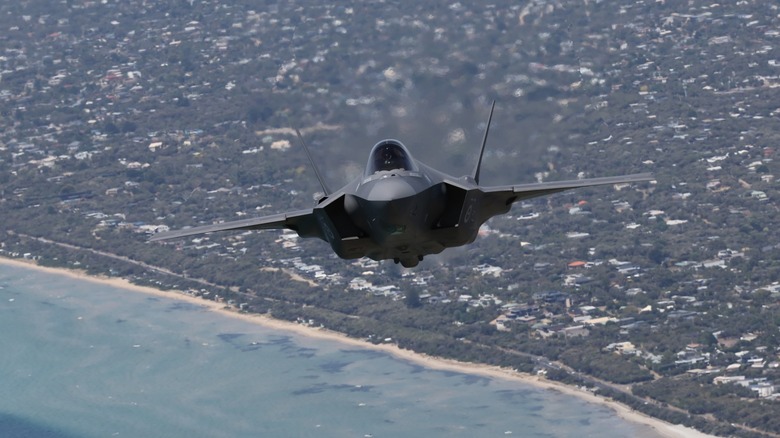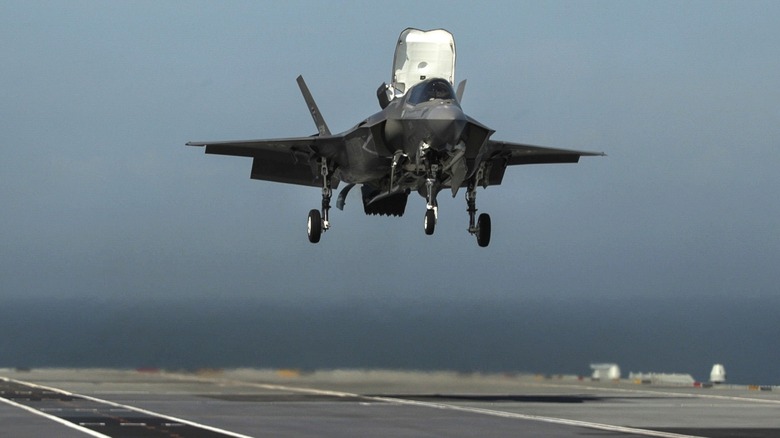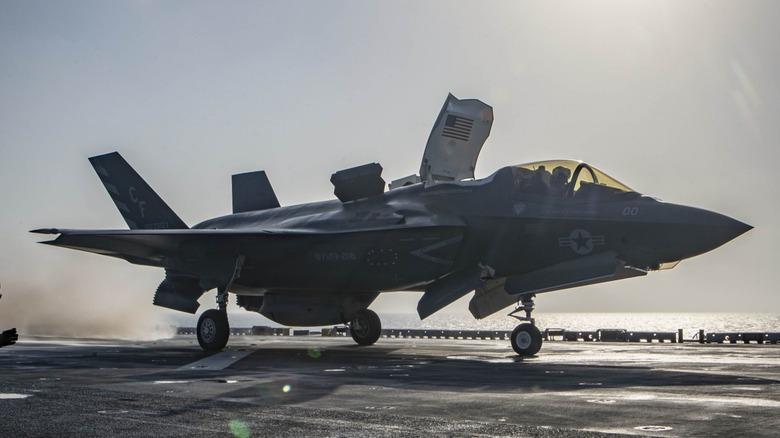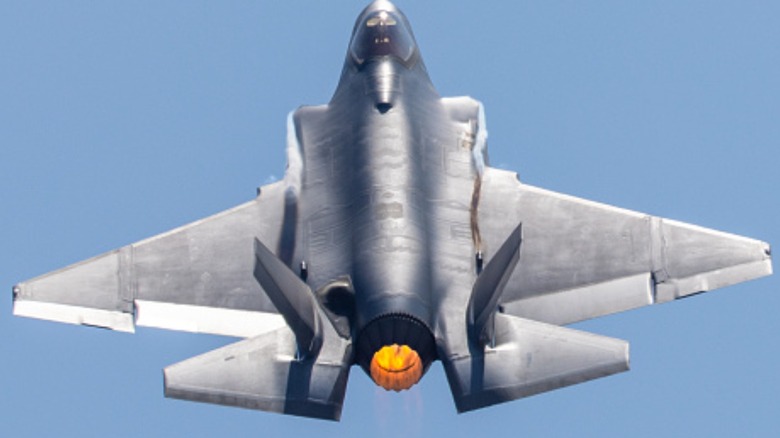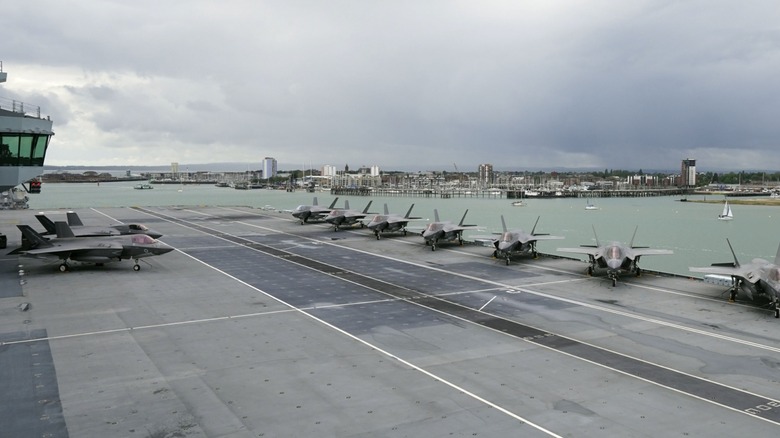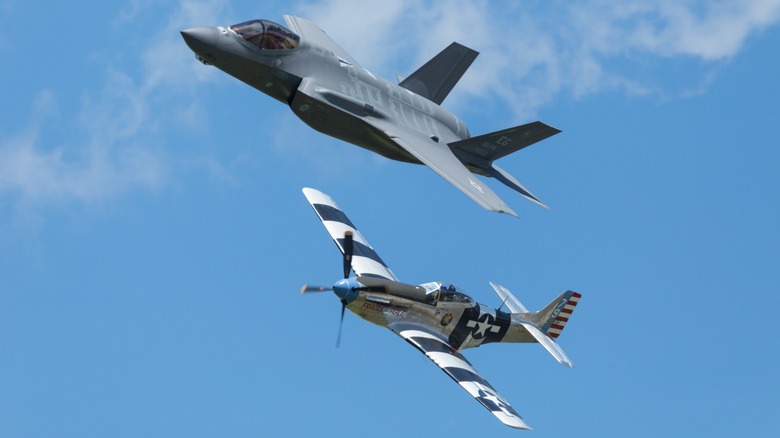F-35 Fighter Jet Variants Explained: The Distinct Features Of Each Model
The Lockheed Martin F-35 Lightning II Joint Strike Fighter is the pinnacle of aviation engineering and jet fighter technology. Though it is an extraordinarily expensive aircraft, it comes packed with the most innovative and technically advanced aeronautical systems manufactured to date. Not only is it used by the United States Air Force, Navy, and Marines, but eight other countries keep this advanced aircraft in their inventories for self-defense. The planned procurement for the United States Armed Forces totals 1,762 units for the Air Force, 693 for the Navy and Marines, and hundreds more for overseas buyers, making it the most numerous of any fifth-generation fighter jet in use today.
Previous fighters have been built with specific roles in mind, such as fighter or bomber, and have been made to be used in specific environments, such as an aircraft carrier. This led to the various branches of the military having multiple airframes to maintain along with the continuous supply chain for parts for each model. The F-35 differs by having a single airframe with various alterations to make it suitable for use in a variety of scenarios while utilizing many of the same parts, thus reducing its logistical overhead. However, this means the F-35 Joint Strike Fighter is built into multiple variants, so here is a look at each one and what makes them unique.
Joint Strike Fighter program background
The story of one of the largest fighter jet programs of the United States Department of Defense (DoD) got its official start in 1996 when the DoD awarded contracts to both Boeing and Lockheed Martin to create a new stealth fighter that could be put into service by the Air Force, Navy, and Marines. While the new aircraft would be built for three service branches, they each had unique requirements, necessitating multiple versions of the aircraft to be built with different specifications.
The end of the Cold War prompted a dramatic shift in military thinking that trickled down from the Pentagon into every area of operation for the military as a whole. Tactics were evolving in this period, and that meant that needs were changing among all branches. Furthermore, budgets were cut in some cases, and funds reallocated in others. This led to a tightening of belts throughout. This is part of the foundation for creating the Joint Strike Fighter Program — to save money. Top brass at the Pentagon wanted a versatile aircraft that would help to reduce costs through economies of scale and the reduction of multiple suppliers.
Both Boeing and Lockheed Martin supplied prototypes in 2001, and Lockheed was awarded the final contract. Being an aviation defense contractor for decades, Lockheed was up to the task, yet problems arose early on and persist until today. Chief among those problems are cost overruns and delays. Furthermore, many suggest it fails to meet the objectives for which it was built. Regardless, the F-35 eventually entered production and is the most advanced stealth fighter jet on the planet today.
F-35A description
Meant to replace the fleet of several aging aircraft like the F-16 Fighting Falcon and A-10 Thunderbolt II, the Air Force received the F-35A variant beginning in 2011. These are powered by a single Pratt and Whitney turbofan engine producing 43,000 pounds of thrust and are built for conventional takeoff and landing (CTOL) as the Air Force primarily operates out of land-based air bases. With less specialized equipment than the other variants, it is the least expensive of the trio.
Designed from the start with a low observable radar cross-section (in other words, stealth), the F-35 combines several elements meant to stay hidden from enemy radar. The fuselage is created such that radar signals will bounce away from the aircraft instead of being redirected back toward the radar signal source. This requires its exterior to be shaped specifically for this purpose and is also coated in an advanced radar-absorbing material. Additionally, all panels and seams must have an absolutely perfect fit because even the smallest panel gap can give away its location.
While it is not perfect, the F-35 assembly in Fort Worth, Texas, provides the best possible aircraft assembly precision in the world. Weapons are also stored in an internal bay for stealth purposes, but the F-35 can still deliver a surprisingly large payload of munitions. While not specifically designed for close-range dogfighting, it is equipped with a 25mm internal cannon should the situation arise.
F-35A operational capabilities
The F-35A used by the Air Force has a wide range of capabilities and can be tailored with various configurations tailored to mission parameters. This will determine what armament will be installed into its two internal weapons bays and whether anything will be affixed to its six external hardpoints that are used when stealth flying is not necessary. Otherwise, all munitions are stored in the weapons bays, which keep them concealed from radar tracking.
As a multirole fighter, this fighter can do more than shoot missiles and bullets at the enemy. It is fitted with an extraordinarily complex and advanced communications suite, which includes an array of sensors that gather multiple data points, heightening situational awareness and sharing it with others involved in a particular mission. Furthermore, an individual F-35A can serve as a communications hub, relaying information to and from other pilots in a squadron, as well as another communications aircraft, such as an AWACS plane, in the area and a Navy command vessel sitting miles offshore. It is a fighter jet that doubles as a complete electronic warfare command station in the sky.
Although the United States Military has had a presence in the Middle East for decades, F-35 fighters were only recently deployed to the area beginning in 2019. These arrived in the area from Hill Air Force Base in Utah. The range of an F-35A is more than 1,350 miles using internal fuel tanks, but the Air Force operates a fleet of tanker aircraft, effectively giving their F-35As unlimited range with aerial refueling and the ability to deploy from Utah directly to the United Arab Emirates.
F-35B description
With a directive as an expeditionary force, the United States Marine Corps is tasked with establishing a foothold in the littoral zone where a mission will occur. This is why their variant of the F-35 is so unique.
Whereas the F-35A, operated by the Air Force, is a traditional fighter for missions originating at air bases with runways, the F-35B is meant for operating at sea. It has an additional fan at the rear of the cockpit that provides additional thrust directly downward, giving this aircraft short takeoff and vertical landing (STOVL) capability. This is done by a combination of shaft-driven thrust fans, the Rolls-Royce LiftSystem, installed just behind the cockpit and the rear thrust nozzle.
This splits the power between the main engine, providing thrust through its nozzle, and the shaft, driving a pair of counter-rotating fans blowing around 20,000 pounds of unheated air down through a vane box that directs the airflow. The rear thrust nozzle is fitted with a three-bearing swivel nozzle (3BSN). This can rotate the nozzle 90 degrees such that its thrust is also directed straight down. To keep low radar observability intact, the downward thrust fans are fully enclosed in a compartment within the airframe.
Marines have operated STOVL aircraft for years. Perhaps the best-known model is the Harrier Jump Jet. By creating a new fighter that can be equipped with this system, the Marines get access to a cutting-edge stealth jet with STOVL capability without having to maintain another individual piece of equipment with its own separate supply line.
F-35B capabilities
The Marine Corps is an expeditionary force tasked with securing beachheads and establishing its presence on the shores and openings into other waterways. They have an extremely important mandate when moving into hostile territory, making quick maneuvers with little infrastructure or support available. This can also include some degree of island hopping, depending on where an objective is to be met. The F-35B is uniquely qualified to help them obtain their objectives in these situations. Without the luxury of well-maintained airstrips, operating with little to no runways is crucial.
The F-35B can take off with almost no runway and hover in place for short periods. This also gives it the ability to land vertically. While some units operate alongside the Navy and use its carriers to execute missions, the Corps also maintains a fleet of its own ships. The newest America-class assault ships have been built with a focus on aviation, providing facilities for operating the F-35B.
Built with a flight deck much shorter and smaller than an aircraft carrier, the Marines can run sorties with their F-35B aircraft while maintaining much of the same capabilities that other branches realize with their aircraft. The tradeoff for having STOVL is less payload capacity and shorter range. However, when each service branch works together to exploit the strengths of all three variants, the results will be overwhelming.
F-35C description
The United States Navy has a long and proud history of serving its country in times of war and peace, defending its shores, and mitigating threats in faraway oceans. It has also maintained its fleet of fighter aircraft, more often than not using its own models built with specific naval requirements in the design. As a result, the Navy has trained some of the best pilots in the world who support our ground-based forces with overwhelming air power against adversaries and is equipped with some of the best fighter jets ever created.
The Navy received the F-35C variant, optimized for use on aircraft carriers. Most of its specifications are in line with the Air Force version, but a few key differences separate it. The most prominent difference is in the wings. For carrier duty, the airframe uses folding wingtips that allow for more compact storage. It is also optimized for carrier duty by having stronger landing gear and a strengthened airframe meant to absorb the immense energy from tailhook carrier landings and catapult-assisted takeoffs.
The wings, which are nine feet wider than the others, and the tail section have larger control surfaces that assist in low-speed approaches while offering a greater load capacity and increased range. Despite having these many alterations, few tradeoffs are made to operational effectiveness, meaning the F-35C is ready for nearly any mission as the other variants in service.
F-35C capabilities
The Navy variant of the F-35C possesses the same communications suite as the others, which is crucial in coordinating with the ships in a carrier strike group, which can be made up of the aircraft carrier accompanied by guided-missile cruisers, destroyers, frigates, submarines, and a supply ship. This includes the relaying of intelligence gathered from its advanced sensors to commanders in real-time, giving them the ability to make informed decisions and give orders based on up-to-date tactical information. Communication between all the commanders and a squadron of aircraft is crucial to executing missions and keeping personnel safe.
The inclusion of the F-35C on the flight deck represents the introduction of stealth fighters for the first time into navy deployments. This gives Naval squadrons superior survivability with the ability to strike inland undetected and return rapidly back to the safety of the strike group. Previous pilots have had to rely on their cunning to pull off the same missions.
While the F-35C has been around for several years, its first deployment with a carrier strike group occurred only in 2021. The first time at sea was with the USS Carl Vinson for a routine deployment in which they performed several naval exercises on the open ocean. Thus, no data yet exists on how the jet performs in a real combat situation.
Future of the F-35
Many fighter jets built over the last 70 years have had surprisingly long shelf lives. Some of the Soviet aircraft built in the '50s and '60s are still flown by developing nations in Asia and Africa. That said, American jets are cycled out of inventory much faster than that, especially as the DoD continues to come up with more advanced airframes every decade or so.
An F-35 is built with a planned life expectancy of about 8,000 hours. The expected annual flight time is different for each variant. The F-35A is planned for 250 hours, with 300 hours for the F-35B and 316 hours for the F-35C. That gives an overall range of between 25 and 32 years, although new planes are being built all the time, which can extend the program's lifetime for decades. Regardless of which variant we are talking about, these jets will be around for a long time, and at a cost of $1.7 trillion, the DoD had better be getting every last minute out of them.
Eight foreign militaries also fly the F-35, including a mix of NATO members and other U.S. allies, such as Singapore, Israel, and Japan. As the aircraft ages, more countries will want to get their hands on this advanced stealth fighter, and as long as they play by the rules, some of them will receive them. Regardless, it looks like the F-35 will continue to be the world's most advanced stealth fighter for many years to come.
